三年级英语名词单数变复数规则和练习及答案
小学三年级英语名词单复数变化练习题40题含答案解析
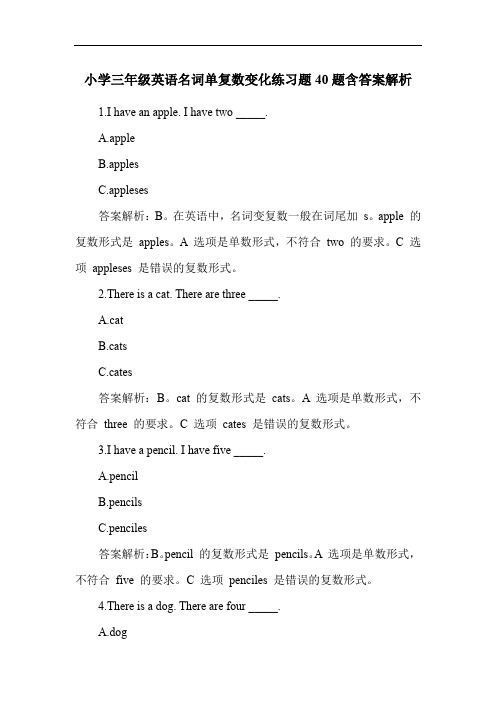
小学三年级英语名词单复数变化练习题40题含答案解析1.I have an apple. I have two _____.A.appleB.applesC.appleses答案解析:B。
在英语中,名词变复数一般在词尾加s。
apple 的复数形式是apples。
A 选项是单数形式,不符合two 的要求。
C 选项appleses 是错误的复数形式。
2.There is a cat. There are three _____.A.catB.catsC.cates答案解析:B。
cat 的复数形式是cats。
A 选项是单数形式,不符合three 的要求。
C 选项cates 是错误的复数形式。
3.I have a pencil. I have five _____.A.pencilB.pencilsC.penciles答案解析:B。
pencil 的复数形式是pencils。
A 选项是单数形式,不符合five 的要求。
C 选项penciles 是错误的复数形式。
4.There is a dog. There are four _____.A.dogB.dogsC.doges答案解析:B。
dog 的复数形式是dogs。
A 选项是单数形式,不符合four 的要求。
C 选项doges 是错误的复数形式。
5.I have an orange. I have six _____.A.orangeB.orangesC.orangeses答案解析:B。
orange 的复数形式是oranges。
A 选项是单数形式,不符合six 的要求。
C 选项orangeses 是错误的复数形式。
6.There is a book. There are seven _____.A.bookB.booksC.bookes答案解析:B。
book 的复数形式是books。
A 选项是单数形式,不符合seven 的要求。
C 选项bookes 是错误的复数形式。
三年级英语名词单复数变化练习题30题(带答案)

三年级英语名词单复数变化练习题30题(带答案)1. I have a ____ (cat/cats).答案:cat。
解析:a后面接单数名词,cat是单数形式,表示一只猫。
2. There are three ____ (banana/bananas) in the basket.答案:bananas。
解析:three表示三个,后面要接复数名词,banana 的复数形式是bananas。
3. My sister has a ____ (pencil/pencils).答案:pencil。
解析:a后面跟单数名词,pencil是单数形式,意思是一支铅笔。
4. There are five ____ (dog/dogs) in the park.答案:dogs。
解析:five表示五个,后面要接复数名词,dog的复数形式是dogs。
5. I see a ____ (pear/pears) on the tree.答案:pear。
解析:a后面接单数名词,pear是单数形式,表示一个梨。
6. There are four ____ (book/books) on the desk.答案:books。
解析:four表示四个,后面要接复数名词,book的复数形式是books。
7. He has a ____ (mouse/mice).答案:mouse。
解析:a后面跟单数名词,mouse是单数形式,意思是一只老鼠。
8. There are two ____ (orange/oranges) in my hand.答案:oranges。
解析:two表示两个,后面要接复数名词,orange 的复数形式是oranges。
9. She has a ____ (ruler/rulers).答案:ruler。
解析:a后面接单数名词,ruler是单数形式,表示一把尺子。
10. There are six ____ (bird/birds) in the sky.答案:birds。
三年级名词单复数练习题及讲解

三年级名词单复数练习题及讲解一、名词的单数变复数在英语中,名词的单复数形式有规律可循。
下面是一些常见的名词单复数变化规则。
1. 一般情况下,我们在名词末尾加上“s”来表示复数形式。
例如:- book(书)→ books(书籍)- toy(玩具)→ toys(玩具)2. 如果名词以“s”、“x”、“ch” 或者“sh”结尾,我们在末尾加上“es”来表示复数形式。
例如:- bus(公交车)→ buses(公交车)- box(盒子)→ boxes(盒子)- watch(手表)→ watches(手表)- brush(刷子)→ brushes(刷子)3. 如果名词以辅音字母+y结尾,我们将“y”改为“ies”来表示复数形式。
例如:- baby(婴儿)→ babies(婴儿)- butterfly(蝴蝶)→ butterflies(蝴蝶)4. 如果名词以“f”或者“fe”结尾,我们通常将“f”或者“fe”改为“ves”来表示复数形式。
例如:- leaf(叶子)→ leaves(叶子)- knife(刀子)→ knives(刀子)5. 另外还有一些名词的复数形式是不规则的,需要进行单独记忆。
例如:- child(孩子)→ children(孩子)- tooth(牙齿)→ teeth(牙齿)二、练习题根据上述规则,将下列名词的单数形式变为复数形式。
1. cat(猫)2. dog(狗)3. pencil(铅笔)4. tomato(番茄)5. box(盒子)6. child(孩子)7. leaf(叶子)8. knife(刀子)9. book(书)10. tooth(牙齿)三、答案及讲解1. cats(猫)2. dogs(狗)3. pencils(铅笔)4. tomatoes(番茄)5. boxes(盒子)6. children(孩子)7. leaves(叶子)8. knives(刀子)9. books(书)10. teeth(牙齿)以上是关于名词单复数变化的练习题及讲解。
三年级英语名词单数变复数规则和练习及答案

三年级英语名词单数变复数规则和练习及答案内部编号:(YUUT-TBBY-MMUT-URRUY-UOOY-DBUYI-0128)三年级名词单数变复数规则1.一般情况下,直接加s如:apple-apples pig-pigs book-books2.以s、sh、ch、x结尾的名词,加es如:bus-buses(公车) class-classes(班级)fish-fishes(此时的fish当“鱼的种类”讲)watch-watches(手表) box-boxes(盒子) fox-foxes(狐狸)3.以元音字母+y结尾的名词,直接加s如:boy-boys(男孩) toy-toys(玩具)4.以辅音字母+y结尾的名词,去y改ies如:family-families(家庭) strawberry-strawberries(草莓)5.以f或fe结尾的名词,去f或fe改ves如:wife-wives knife-knives wolf-wolves(这三个词的记忆口诀---“妻子”拿着“小刀”杀了“狼”)6.以”o"结尾的名词:(1)有生命的,加es,如:potato-potatoes tomato-tomatoes hero-heroes(这三个词的记忆口诀---”英雄“爱吃”土豆“和”西红柿“)(2)无生命的,加s .如:photo-photos(照片) radio-radios(收音机)Piano—pianos(钢琴)7.将“oo”改为“ee"的名词如:tooth-teeth(牙) foot-feet(脚) goose-geese(鹅)8.单复同形的名词:(1)f ish-fish(此时fish当“同类鱼的很多条”讲)sheep-sheep(绵羊) paper-paper(纸)people-people(peoples表示“民族”)Chinese-Chinese(中国人) Japanese-Japanese(日本人)(2)不可数名词,如:water(水),rice(米饭),milk(牛奶),juice(果汁),bread(面包),tea(茶),orange(橙汁)9.不规则变化的名词:(1)m an-men,woman-women (记忆方法,“男人”变“女人”,“a”变“e”.延伸policeman-policemen policewoman-policem(2)c hild-children(孩子)(3)m ouse-mice(老鼠)(4)根据中文意思变化的名词,如:I-we (我-我们) you-you (你-你们)he/she/it-they (他/她/它-他们)this-these(这个-这些) that-those(那个-那些)am/is –are (是) has-have(有)注:apple tree-apple trees man teacher-men teachers以此类推课堂练习一.出下列各词的复数。
三年级英语名词单数变复数规则和练习及标准答案

三年级英语名词单数变复数规则和练习及答案————————————————————————————————作者:————————————————————————————————日期:三年级名词单数变复数规则1.一般情况下,直接加s如:apple-apples pig-pigs book-books2.以s、sh、ch、x结尾的名词,加es如:bus-buses(公车) class-classes(班级)fish-fishes(此时的fish当“鱼的种类”讲)watch-watches(手表) box-boxes(盒子) fox-foxes(狐狸) 3.以元音字母+y结尾的名词,直接加s如:boy-boys(男孩) toy-toys(玩具)4.以辅音字母+y结尾的名词,去y改ies如:family-families(家庭) strawberry-strawberries(草莓) 5.以f或fe结尾的名词,去f或fe改ves如:wife-wives knife-knives wolf-wolves(这三个词的记忆口诀---“妻子”拿着“小刀”杀了“狼”)6.以”o"结尾的名词:(1)有生命的,加es,如:potato-potatoes tomato-tomatoes hero-heroes (这三个词的记忆口诀---”英雄“爱吃”土豆“和”西红柿“)(2)无生命的,加s .如:photo-photos(照片) radio-radios(收音机) Piano—pianos(钢琴)7.将“oo”改为“ee"的名词如:tooth-teeth(牙) foot-feet(脚) goose-geese(鹅)8.单复同形的名词:(1)f ish-fish(此时fish当“同类鱼的很多条”讲)sheep-sheep(绵羊) paper-paper(纸)people-people(peoples表示“民族”)Chinese-Chinese(中国人) Japanese-Japanese(日本人)(2)不可数名词,如:water(水),rice(米饭),milk(牛奶),juice(果汁),bread(面包),tea(茶),orange(橙汁)9.不规则变化的名词:(1)m an-men,woman-women (记忆方法,“男人”变“女人”,“a”变“e”.延伸policeman-policemen policewoman-policem (2)c hild-children(孩子)(3)m ouse-mice(老鼠)(4)根据中文意思变化的名词,如:I-we (我-我们) you-you (你-你们)he/she/it-they (他/她/它-他们)this-these(这个-这些) that-those(那个-那些)am/is –are (是) has-have(有)注:apple tree-apple trees man teacher-men teachers以此类推课堂练习一.出下列各词的复数。
小学三年级英语名词单复数变化练习题40题含答案解析
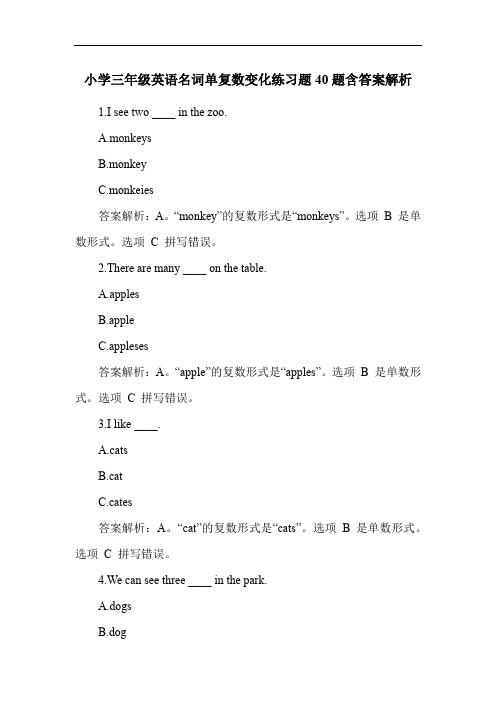
小学三年级英语名词单复数变化练习题40题含答案解析1.I see two ____ in the zoo.A.monkeysB.monkeyC.monkeies答案解析:A。
“monkey”的复数形式是“monkeys”。
选项B 是单数形式。
选项C 拼写错误。
2.There are many ____ on the table.A.applesB.appleC.appleses答案解析:A。
“apple”的复数形式是“apples”。
选项B 是单数形式。
选项C 拼写错误。
3.I like ____.A.catsB.catC.cates答案解析:A。
“cat”的复数形式是“cats”。
选项 B 是单数形式。
选项C 拼写错误。
4.We can see three ____ in the park.A.dogsB.dog答案解析:A。
“dog”的复数形式是“dogs”。
选项B 是单数形式。
选项C 拼写错误。
5.There are some ____ in the basket.A.pearsB.pearC.peares答案解析:A。
“pear”的复数形式是“pears”。
选项B 是单数形式。
选项C 拼写错误。
6.I have two ____.A.rabbitsB.rabbitC.rabbites答案解析:A。
“rabbit”的复数形式是“rabbits”。
选项B 是单数形式。
选项C 拼写错误。
7.There are four ____ in the field.A.cowsB.cowC.cowes答案解析:A。
“cow”的复数形式是“cows”。
选项B 是单数形式。
选项C 拼写错误。
8.We can see five ____ in the zoo.B.tigerC.tigres答案解析:A。
“tiger”的复数形式是“tigers”。
选项B 是单数形式。
选项C 拼写错误。
9.There are six ____ on the tree.A.bananasB.bananaC.bananaes答案解析:A。
名词单复数练习及答案

名词单复数练习及答案一、名词单数变复数规则练习在英语中,将名词从单数变成复数通常需要根据不同的规则进行变化。
以下是一些常见的名词单数变复数的规则:1. 一般在名词末尾加s例:book → books2. 以s, x, ch, sh结尾的名词,在末尾加es例:bus → buses3. 以辅音字母+y结尾的名词,将y变成i,再加es例:baby → babies4. 以辅音字母+o结尾的名词,在末尾加es例:potato → potatoes5. 以辅音字母+f或fe结尾的名词,将f或fe变成v,再加es例:leaf → leaves现在,请你根据以上规则将下面的名词单数变成复数形式:1. cat2. house3. toy5. brush二、名词复数变单数规则练习除了将名词从单数变成复数外,有时候也需要将名词从复数变成单数。
以下是一些常见的名词复数变单数的规则:1. 一般在名词末尾去掉s例:dogs → dog2. 以s, x, ch, sh结尾的名词,去掉es例:watches → watch3. 以辅音字母+y结尾的名词,将y变成i,再去掉es例:butterflies → butterfly4. 以辅音字母+o结尾的名词,去掉es例:potatoes → potato5. 以辅音字母+f或fe结尾的名词,将f或fe变成v,再去掉es例:leaves → leaf现在,请你根据以上规则将下面的名词复数变成单数形式:1. books2. houses4. boxes5. brushes三、名词单复数变化答案以下是名词单复数的答案:一、名词单数变复数规则练习答案1. cats2. houses3. toys4. boxes5. brushes二、名词复数变单数规则练习答案1. book2. house3. toy4. box5. brush通过以上练习,希望你能更加熟练地掌握名词单复数的变化规则,提高你的英语写作能力。
小学三年级英语名词单复数变化练习题40题带答案
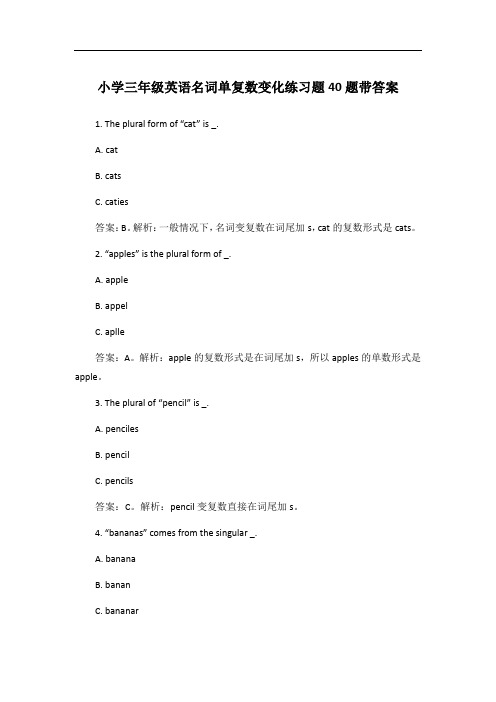
小学三年级英语名词单复数变化练习题40题带答案1. The plural form of “cat” is _.A. catB. catsC. caties答案:B。
解析:一般情况下,名词变复数在词尾加s,cat的复数形式是cats。
2. “apples” is the plural form of _.A. appleB. appelC. aplle答案:A。
解析:apple的复数形式是在词尾加s,所以apples的单数形式是apple。
3. The plural of “pencil” is _.A. pencilesB. pencilC. pencils答案:C。
解析:pencil变复数直接在词尾加s。
4. “bananas” comes from the singular _.A. bananaB. bananC. bananar答案:A。
解析:banana的复数形式是bananas,所以bananas的单数形式是banana。
5. The plural form of “dog” is _.A. dogB. dogsC. doges答案:B。
解析:dog变复数在词尾加s。
6. “oranges” is the plural of _.A. orangeB. orangC. orenge答案:A。
解析:orange的复数形式是在词尾加s变成oranges。
7. The plural of “book” is _.A. bookB. booksC. bookies答案:B。
解析:book变复数在词尾加s。
8. “grapes” is the plural form of _.A. grapeB. grapC. graper答案:A。
解析:grape的复数形式是grapes。
9. The plural of “eraser” is _.A. eraserB. erasersC. eraseres答案:B。
三年级英语名词单复数变化练习题30题含答案解析

三年级英语名词单复数变化练习题30题含答案解析1.I have a cat. I see two _____.A.catB.catsC.cates答案解析:B。
选项A 是单数形式,不符合题干中“two”的要求;选项C 拼写错误;选项B 是cat 的复数形式,正确。
例如:one cat (一只猫),two cats(两只猫)。
2.There is an apple. There are many _____.A.appleB.applesC.appless答案解析:B。
选项A 是单数形式;选项C 拼写错误;选项B 是apple 的复数形式,正确。
例如:one apple((一个苹果),many apples (许多苹果)。
3.I have a pencil. I see three _____.A.pencilB.pencilsC.penciless答案解析:B。
选项A 是单数形式;选项C 拼写错误;选项B 是pencil 的复数形式,正确。
例如:one pencil((一支铅笔),three pencils (三支铅笔)。
4.There is a dog. There are five _____.A.dogB.dogsC.doges答案解析:B。
选项A 是单数形式;选项C 拼写错误;选项B 是dog 的复数形式,正确。
例如:one dog((一只狗),five dogs((五只狗)。
5.I have an orange. I see four _____.A.orangeB.orangesC.orangeses答案解析:B。
选项A 是单数形式;选项C 拼写错误;选项B 是orange 的复数形式,正确。
例如:one orange(一个橘子),four oranges(四个橘子)。
6.There is a book. There are six _____.A.bookB.booksC.bookes答案解析:B。
小学名词变复数题目及答案

小学名词变复数题目及答案这份文档旨在帮助小学生掌握英语名词复数的构成规则,并通过大量的练习题巩固所学知识。
文档包含了各种类型的名词复数练习,并附有详细的答案解析,力求全面覆盖小学阶段名词复数的学习内容。
一、名词复数构成规则详解英语名词的复数形式通常是在单数名词后加“-s”,但也有许多例外情况。
以下详细讲解各种规则及例外情况:1. 规则变化:加“-s”大多数名词的复数形式是在单数名词后直接加“-s”,例如:•book - books (书)•cat - cats (猫)•dog - dogs (狗)•pen - pens (钢笔)•tree - trees (树)•car - cars (汽车)•girl - girls (女孩)•boy - boys (男孩)•apple - apples (苹果)•banana - bananas (香蕉)2. 规则变化:加“-es”以下几种情况需要在单数名词后加“-es”:•以s, x, ch, sh结尾的名词:这些字母结尾的名词发音比较困难,直接加s会显得不协调,所以要加-es。
o bus - buses (公共汽车)o box - boxes (盒子)o watch - watches (手表)o brush - brushes (刷子)o class - classes (班级)o dish - dishes (盘子)•以辅音字母+y结尾的名词:需要将y改为i再加-es。
o baby - babies (婴儿)o city - cities (城市)o country - countries (国家)o family - families (家庭)o lady - ladies (女士)o story - stories (故事)•以o结尾的名词:部分以o结尾的名词加-es,部分加-s,需要记忆。
o potato - potatoes (土豆)o tomato - tomatoes (西红柿)o hero - heroes (英雄)o echo - echoes (回声)o volcano - volcanoes (火山)o但是:photo - photos (照片), radio - radios (收音机), piano - pianos (钢琴) 等则直接加-s3. 不规则变化一些名词的复数形式变化不规则,需要单独记忆:•man - men (男人)•woman - women (女人)•child - children (孩子)•foot - feet (脚)•tooth - teeth (牙齿)•mouse - mice (老鼠)•ox - oxen (公牛)•goose - geese (鹅)4. 特殊情况•一些名词单复数同形:例如:sheep (绵羊), deer (鹿), fish (鱼), Chinese (中国人), Japanese (日本人) 等。
可数名词单数变复数规则及练习含答案
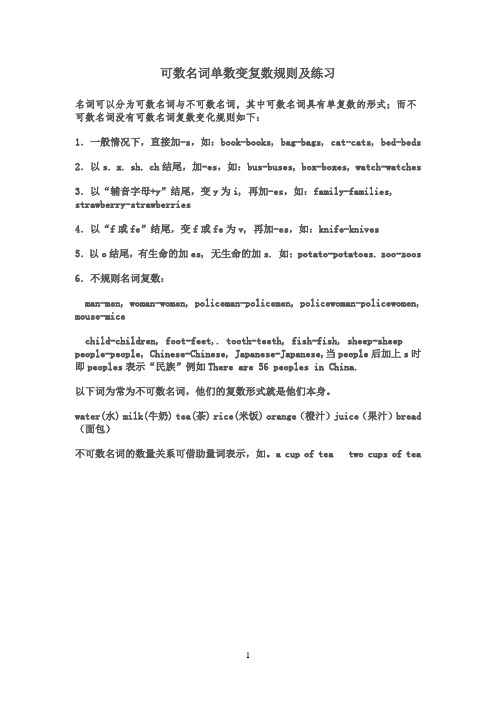
可数名词单数变复数规则及练习名词可以分为可数名词与不可数名词,其中可数名词具有单复数的形式;而不可数名词没有可数名词复数变化规则如下:1.一般情况下,直接加-s,如:book-books, bag-bags, cat-cats, bed-beds2.以s. x. sh. ch结尾,加-es,如:bus-buses, box-boxes, watch-watches3.以“辅音字母+y”结尾,变y为i, 再加-es,如:family-families, strawberry-strawberries4.以“f或fe”结尾,变f或fe为v, 再加-es,如:knife-knives5.以o结尾,有生命的加es, 无生命的加s. 如:potato-potatoes. zoo-zoos6.不规则名词复数:man-men, woman-women, policeman-policemen, policewoman-policewomen, mouse-micechild-children, foot-feet,. tooth-teeth, fish-fish, sheep-sheep people-people, Chinese-Chinese, Japanese-Japanese,当people后加上s时即peoples表示“民族”例如There are 56 peoples in China.以下词为常为不可数名词,他们的复数形式就是他们本身。
water(水) milk(牛奶) tea(茶) rice(米饭) orange(橙汁)juice(果汁)bread (面包)不可数名词的数量关系可借助量词表示,如。
a cup of tea two cups of tea名词复数练习题1).填入所给名词的正确形式1. I have two_____ (knife)2. There are many _____ here. (box)3. There are many _____ on the road. (bus)4. A few ____boys_ are drawing on the wall. (boy)5. The _childen____ are playing football now. (child)2)选择填空1. They come from different ______A. countryB. countriesC. a countryD. countrys2. How many ______ do you see in the picture?A. tomatosB. tomatoesC. tomatoD. the tomato3. There are some ______ in these _______.A.knifes…pencil-boxesB.k nives…pencils-boxC.knives…pencil-boxD.knives…pencils-boxes4. There is no ______ in the plate.A. applesB. orangesC. riceD. eggs5. _______ are good for our health.A. TomatosB. TomatoesC. Tomato6. I like to eat cake with ______.A. cherriesB. cherryC.cherrys7. ______ and ______ are not friends.A. Foxs…wolfsB.Foxes wolfsC.Foxes…wolves8. Do you want to drink much ?A.a milkkks9. This is room. It’s very big.A.Lily and Lucy’sB.Lily’s andLucy’s C.Lily’s and Lucy10. Do you want some for supper?A、a potatoB、potatoesC、potatos11. In autumn,you can see a lot of on the ground.A、leafB、leafsC、leaves12. My sister has two . One is old,the other is new.A、a watchB、watchsC、watches13.There on the wall .They are very beautiful.A. are photoesB. are photosC. is a photoD. is photos14. That’a art book.A. anB. aC. the D are15. There two in the box.A. is watchB. are watchesC. are watchD. is watches 3)请用括号中名词的复数形式填空1. Look at those _______. (child)2. I can see a __________ standing near the door. (policeman)3. Do you want some ________ for dinner? (potato)4. In autumn, you can see a lot of _______ on the ground.(leaf) 5. He has two _______.One is blue , the other is yellow.( box)6. Two ________ live in this building .( family )4)选择正确的词形1. How many (radioes, radios) can you see?2. There are 36 (boys, boies) in my class.3. Look at those (sheeps, sheep).4.I don’t want (a, an) old cup.5. Give me that (box, boxes), please.5)将以下单复数句进行转换1.This is a knife.___________________________________2.That is a tomato.___________________________________3.That child is very good.___________________________________4 .These are mice.___________________________________5.Those are children.___________________________________答案1.knives boxes buses boys children2.BBDCB ACBAB CCBAB3.Children policeman potatoes leaves boxes families4.Radios boys sheep an5.These are knives.Those are tomatoes.Those children are very good.This is rice.That is child.。
三年级名词单复数题目60道

三年级名词单复数题目60道一、单数变复数的基础题目(20道)1. 写出“book”的复数形式。
答案:books。
解析:一般情况下,名词单数变复数,直接在词尾加 -s。
book是规则变化的名词,所以复数是books。
2. 把“pen”变成复数。
答案:pens。
解析:pen也是规则变化,直接加 -s构成复数形式。
3. “ruler”的复数是什么?答案:rulers。
解析:同样遵循一般规则,在词尾加 -s。
4. 将“pencil”变为复数。
答案:pencils。
解析:直接在词尾加 -s得到复数形式。
5. 写出“eraser”的复数形式。
答案:erasers。
解析:按常规在词尾加 -s。
6. “crayon”的复数是?答案:crayons。
解析:直接加 -s。
7. 把“desk”变成复数。
答案:desks。
解析:desk是规则名词,加 -s变为复数。
8. “chair”的复数怎么写?答案:chairs。
解析:在词尾加 -s。
9. 写出“box”的复数形式。
答案:boxes。
解析:以x结尾的名词,变复数时要加 -es。
10. 将“bus”变为复数。
答案:buses。
解析:以s结尾的名词,变复数加 -es。
11. “apple”的复数是什么?答案:apples。
解析:直接加 -s。
12. 把“banana”变成复数。
答案:bananas。
解析:直接加 -s。
13. 写出“pear”的复数形式。
答案:pears。
解析:直接加 -s。
14. 将“orange”变为复数。
答案:oranges。
解析:直接加 -s。
15. “cat”的复数是?答案:cats。
解析:直接加 -s。
16. 把“dog”变成复数。
答案:dogs。
解析:直接加 -s。
17. 写出“bird”的复数形式。
答案:birds。
解析:直接加 -s。
18. 将“fish”变为复数(表示鱼的种类时)。
答案:fishes。
解析:当fish表示鱼的种类时,复数形式是fishes;如果表示鱼肉或者同一种鱼的多条,复数还是fish。
最新三年级英语名词单数变复数规则和练习及答案
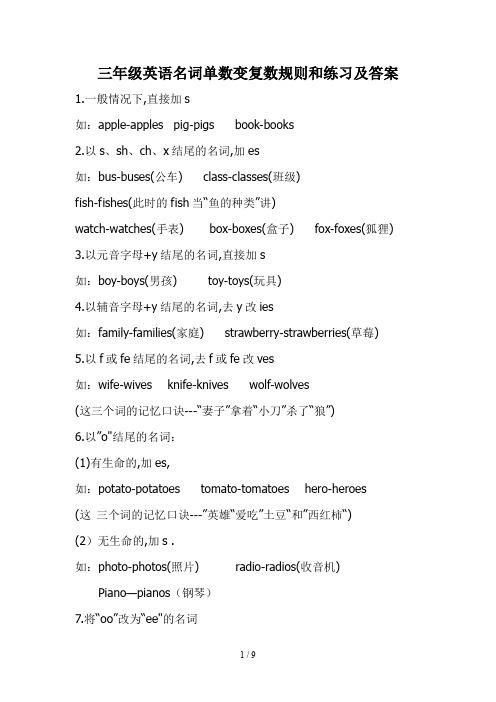
三年级英语名词单数变复数规则和练习及答案1.一般情况下,直接加s如:apple-apples pig-pigs book-books2.以s、sh、ch、x结尾的名词,加es如:bus-buses(公车) class-classes(班级)fish-fishes(此时的fish当“鱼的种类”讲)watch-watches(手表) box-boxes(盒子) fox-foxes(狐狸) 3.以元音字母+y结尾的名词,直接加s如:boy-boys(男孩) toy-toys(玩具)4.以辅音字母+y结尾的名词,去y改ies如:family-families(家庭) strawberry-strawberries(草莓) 5.以f或fe结尾的名词,去f或fe改ves如:wife-wives knife-knives wolf-wolves(这三个词的记忆口诀---“妻子”拿着“小刀”杀了“狼”)6.以”o"结尾的名词:(1)有生命的,加es,如:potato-potatoes tomato-tomatoes hero-heroes (这三个词的记忆口诀---”英雄“爱吃”土豆“和”西红柿“)(2)无生命的,加s .如:photo-photos(照片) radio-radios(收音机) Piano—pianos(钢琴)7.将“oo”改为“ee"的名词如:tooth-teeth(牙) foot-feet(脚) goose-geese(鹅)8.单复同形的名词:(1)f ish-fish(此时fish当“同类鱼的很多条”讲)sheep-sheep(绵羊) paper-paper(纸)people-people(peoples表示“民族”)Chinese-Chinese(中国人) Japanese-Japanese(日本人)(2)不可数名词,如:water(水),rice(米饭),milk(牛奶),juice(果汁),bread(面包),tea(茶),orange(橙汁)9.不规则变化的名词:(1)m an-men,woman-women (记忆方法,“男人”变“女人”,“a”变“e”.延伸policeman-policemen policewoman-policem (2)c hild-children(孩子)(3)m ouse-mice(老鼠)(4)根据中文意思变化的名词,如:I-we (我-我们) you-you (你-你们)he/she/it-they (他/她/它-他们)this-these(这个-这些) that-those(那个-那些)am/is –are (是) has-have(有)注:apple tree-apple trees man teacher-men teachers以此类推课堂练习一.出下列各词的复数。
名词单复数变化(规则变化及练习)

名词单复数变化(一)可数名词单复数规则变化一、理论知识:1. 一般情况下,名词变复数直接加____________如: book ______ _______ car _______ _______ chair _______ _____friend ______ ______ desk ______ _____ girl ______ ______2. 以___________、___________、___________、___________ 结尾的名词加_es 变成复数如: bus ________ ________ watch ________ ________brush ________ ________ box ________ ________bush ________ ________ fox ________ ________3. 以f或fe 结尾的名词,变复数为,变__________为__________ 再加__________ 如:wife ______ ______ shelf ______ _______ wolf ______ ______leaf ________ ________ life ________ ________口诀:小偷的妻子一生中只注意架子上的小刀,树叶和自己的半匹狼thief wife life shelf knife, leaf, self half wolf 4. 以“辅音字母+y”结尾的,名词,变复数为:________________________________如: factory ________ ________ country ________ ________city ________ ________ story ________ ________5. 以“原音字母+y”结尾的名词,变复数为: ________________________________如: boy _______ ______ day ______ ______ toy ______ ______6. 以字母“o”结尾的名词,一般情况下变复数加________________如: photo ______ ______ zoo ______ ______ radio ______ ______7. 有些以“o” 结尾的名词,变复数加________________如: potato _______ _______ tomato ________ ________ hero ________ ________ Negro ________ ________ echo ________ ________(二)可数名词的不规则变化一、理论知识1. 变单词本身字母如:foot ________ ________ tooth ________ ________ goose ________ ________ man ________ ________ woman ________ ________ mouse ________ ________ child ________ ________ ox ________ ________2. 单复数同行sheep ________ ________ deer ________ ________ fish ________ ________ Chinese________ ________ Japanese ________ ________ Swiss ________ ________ 口诀:中国人,日本人还有瑞士人都喜欢吃羊,鹿,鱼Chinese Japanese Swiss sheep deer fish4. 国人的变化(1) 中、日不变Chinese___________ ___________ Japanese___________ ___________(2) 英、法a 变eEnglishman ___________ ___________ Frenchman ___________ ___________ (3) 其他一律加sGerman ___________ ___________ American ___________ ___________Australian ___________ ___________ Canadian ___________ ___________(口诀:中日不变,英法变,其他一律加s)5.以下单词是集体名词,本身就只有复数的形式people 人们glasses 眼镜clothes 衣服police 警察trousers 裤子scissors 剪刀family 家人thanks 感谢compass 圆规shoes 鞋子socks 袜子写出下列名词的复数形式,并写出各词的汉语意思watch ______ ______ boy ______ ______ shoe ______ ______ student ______ ______ girl ______ ______ leg ______ ______ cup ______ ______ train ______ ______ shelf ______ ______ fox ______ ______ brush ______ ______ class ______ ______ map ______ ______ roof ______ ______ tool ______ ______ tree ______ ______ potato ______ ______ piano ______ ______ holiday ______ ______ Negro ______ ______ chief ______ ______ mouth ______ ______ piece ______ ______ year ______ ______ way ______ ______ body ______ ______ banana ______ ______ watch ______ ______ factory ______ ______ library ______ ______ chair ______ ______ tomato ______ ______ brush ______ ______ monkey ______ ______ dress ______ ______ match ______ ______ orange ______ ______ wife ______ ______ belief ______ ______ party ______ ______ Chinese ______ ______ hero ______ ______ park ______ ______ railway ______ ______ word ______ ______ reef ______ ______ Frenchman ______ ______ sheep ______ ______ tooth ______ ______ photo ______ ______ university ______ ______ brief ______ ______ glass ______ ______ teacher ______ ______ hand ______ ______ foot ______ ______ mouse ______ ______ shirt ______ ______ apple ______ ______ deer ______ ______ German ______ ______ Englishman ______ ______ fish ______ ______ Negro ______ ______ family ______ ______ skirt ______ ______ piano ______ ______ month ______ ______ serf ______ ______ giraffe ______ ______ radio ______ ______ chimney ______ ______ train ______ ______ station ______ ______ house ______ ______ classroom ______ ______ office ______ ______ monkey ______ ______ baby ______ ______ leaf ______ ______ kite ______ ______ knife ______ ______ proof ______ ______ reef ______ ______ story ______ ______ thief ______ ______ brother ______ ______名词单复数变化练习用所给词的适当形式填空1. My parents are all ___________ (teacher).2. The desk has four ___________ (leg).3. There are many ___________ (sheep) on the hill.4. A dog has four ___________ (foot).5. There are twelve ___________ (month) in a year and seven ___________ (day) in a week.6. How many ___________ (tomato) are there in the fridge?7. There are three ___________ (apple) and two ___________ (egg) on the plate.8. These black ___________ (mouse) look terrible.9. There are four ___________ (person) in my family.10. We are ___________ (Chinese).They are ___________ (American).11. The little boy has four ___________ (tooth).12. Lily and Lucy are ___________ (Japanese).13. Why do you bring two ___________ (knife) with you?14. Jim and Mary are from different ___________ (country), they are four ___________ (class) from Monday to Friday.15. There are many ___________ (tree) on either side of the street.16. There are fifty ___________ (state) in the USA.17. Can you another two ___________ (cake)?18. How many ___________ (family) are there in the village?19. Seven ___________ (student) are taking ___________ (photo) over there.20. I have four ___________ (watch).21. The ___________ (German) are going to Paris.22. These ___________ (child) are ___________ (Englishman).23. Shanghai is one of the biggest ___________ (city) in China.24. The ___________ (leaf) turn yellow in autumn.25. There are four ___________ (season) in a year and three ___________ (month) in a season.26. There are thirty ___________ (boy) and twenty ___________ (girl) in the class.27. I have one _________ (mouth), two ________ (eye), and two _________ (foot).28. The ___________ (policeman) are in the station.29. We took many ___________ (photo) in the park.30. There are not many ___________ (fish) in the river.31. I want to be a ___________ (scientist) in the future.32. We have many ___________ (book) on the desk.33. This pair of ___________ (glass) is too small for me.34. Please give my best ___________ (wish) for your parents.35. These ___________ (photo) are old.36. Those ___________ (child) are lovely.37. The ___________ (hero) are ___________ (German).38. There are two ___________ (factory) near my home and two thirds of the workers are___________ (Chinese).39. The ten ___________ (question) are hard to work out.40. There are twenty-four ___________ (hour) in a day.41. The two ___________ (man) are ___________ (Englishman).42. There are many ___________ (sheep) and ___________ (deer) on the grass.43. Here are three ___________ (goose). There are many ___________ (ox).44. I am thirsty. Please give me four ___________ (glass) of drink.45. There are a lot of ___________ (bus) in the street.46. My parents have two ___________ (child).47. The old man’s sisters are ___________ (Australian).48. The little girl has two ___________ (pen).49. I received two ___________ (letter) yesterday.50. They have many ___________ (child), but none of them likes to wash ___________ (dish).51. Six of them are ___________ (worker), but Mr. Liu and Mr. Li are ___________ (postman).52. How many ___________ (radio) are there in the room?53. This passage has four ___________ (part).54. The two ___________ (boy) are my ___________ (friend).55. These ___________ (student) are our ___________ (classmate).补充词汇:best 最好的friend 朋友from 来自question 问题big 大的small 小的police 警察fifty 五十Monday 星期一Friday 星期五side 边either 两者之一letter 信knife 小刀twelve 十二person 人future 将来scientist 科学家work out 算出lovely 可爱的postman 邮递员part 部分radio 收音机classmate 同学parents 父母亲bring 带来station 车站factory 工厂leg 腿different 不同的leaf 树叶third 第三hill 小山country 国家yellow 黄色的grass 草地these 这些cake 蛋糕autumn 秋天thirsty 渴的those 那些state 州season 季节receive 收到fridge 冰箱village 村庄thirty 三十yesterday 昨天。
小学三年级英语名词单复数变化练习题40题(带答案)

小学三年级英语名词单复数变化练习题40题(带答案)1. I have a cat. I see two _____.A.catB.catsC.cates答案解析:B。
本题考查名词单复数变化。
一般情况下,名词变复数直接在词尾加s。
cat 的复数是cats。
A 选项是单数形式不符合题意。
C 选项拼写错误。
2. There is an apple. There are three _____.A.appleB.applesC.applys答案解析:B。
apple 的复数是apples,直接在词尾加s。
A 选项是单数形式。
C 选项拼写错误。
3. I see a dog. I see five _____.A.dogB.dogsC.doges答案解析:B。
dog 的复数是dogs。
A 选项是单数形式。
C 选项拼写错误。
4. There is a banana. There are four _____.A.bananaB.bananasC.bananies答案解析:B。
banana 的复数是bananas。
A 选项是单数形式。
C 选项拼写错误。
5. I have a rabbit. I see six _____.A.rabbitB.rabbitsC.rabitts答案解析:B。
rabbit 的复数是rabbits。
A 选项是单数形式。
C 选项拼写错误。
6. There is an orange. There are seven _____.A.orangeB.orangesC.orangeses答案解析:B。
orange 的复数是oranges。
A 选项是单数形式。
C 选项错误。
7. I see a duck. I see eight _____.A.duckB.ducksC.duckes答案解析:B。
duck 的复数是ducks。
A 选项是单数形式。
C 选项拼写错误。
8. There is a pear. There are nine _____.A.pearB.pearsC.peares答案解析:B。
小学三年级英语名词单复数变化练习题40题(答案解析)

小学三年级英语名词单复数变化练习题40题(答案解析)1.I see a cute cat. There are many cats in the yard. Which one is correct?A.catB.catsC.cates答案解析:B。
“cat”是单数形式,“cats”是复数形式,很多猫要用复数形式cats。
“cates”是错误的拼写形式。
2.There is an apple on the table. There are many apples in the basket. Which one is correct?A.appleB.applesC.appleses答案解析:B。
“apple”是单数形式,“apples”是复数形式,很多苹果要用复数形式apples。
“appleses”是错误的拼写形式。
3.I like monkey. I see many monkeys at the zoo. Which one is correct?A.monkeyB.monkeysC.monkeies答案解析:B。
“monkey”是单数形式,“monkeys”是复数形式,很多猴子要用复数形式monkeys。
“monkeies”是错误的拼写形式。
4.There is a pear. There are some pears on the plate. Which one is correct?B.pearsC.peares答案解析:B。
“pear”是单数形式,“pears”是复数形式,一些梨要用复数形式pears。
“peares”是错误的拼写形式。
5.I see a dog. There are many dogs in the park. Which one is correct?A.dogB.dogsC.doges答案解析:B。
“dog”是单数形式,“dogs”是复数形式,很多狗要用复数形式dogs。
小学英语语法名词单复数变化规律原则及名词时态变化专项练习题和答案

语法专项练习--名词单复数用法+练习题+答案一、名词:表示某一事物的名词。
1.专有名词:人名,地名,机构等专有的名称,如Beijing、China等。
2.普通名词:①可数名词:可以用数目来计算的具体的个体名词和集体名词。
②不可数名词,无法用数目计算的物质名词和抽象名词。
二、名词变复数(可数名词变复数)1、原理:be 动词如果是am、is或was,名词就用原形;be动词如果是are或were,名词就加s或es。
注意:不可数名词都默认为单数,所以总是用is或者was;最好不要根据 some、any、alot of等作判断,以免受误导。
2、如何加后缀:①一般情况下,直接加-s,如:book-books,bag-bags,cat-cats,bed-beds②以s.x.sh.ch结尾,加-es,如:bus-buses,box-boxes,brush-brushes, watch-watches③以“辅音字母+y”结尾,变y为i,再加-es,如:family-families,strawberry-strawberries④以“f或fe”结尾,变f或fe为v,再加-es,如:knife-knives⑤以元音字母+y结尾的名词变复数时,直接加s变复数,如:monkey---monkeys holiday---holidays⑥以o结尾的名词,变复数时:加s,如:photo---photos zoo---zoos加es如:potatoes,tomatoes⑦不规则名词复数:fish-fish,man-men,woman-women,policeman-policemen,policewoman-policewomen,foot-fe et,child-children tooth-teeth,people-people,Chinese-Chinese,Japanese-Japanese,mouse-mice注意:1)单复同形如:deer,sheep,fish Chinese Japanese 2) 集体名词,以单数形式出现,但实为复数。
小学英语名词单数变复数的语法规则及练习题含答案
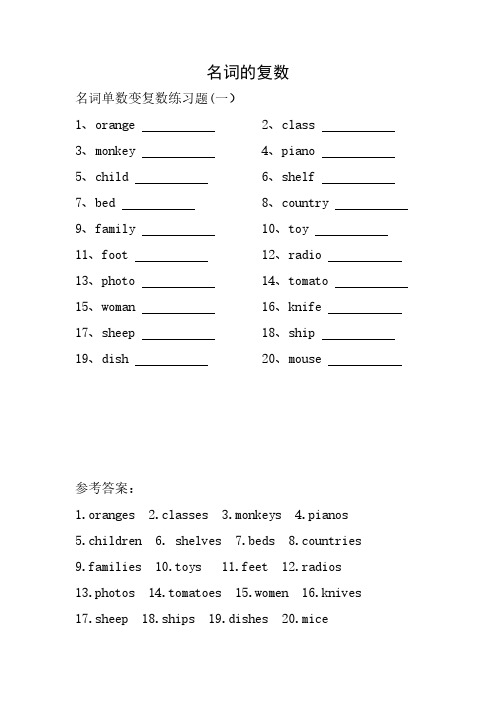
名词的复数名词单数变复数练习题(一)1、orange2、class3、monkey4、piano5、child6、shelf7、bed8、country9、family10、toy11、foot12、radio13、photo14、tomato15、woman16、knife17、sheep18、ship19、dish20、mouse参考答案:1.oranges2.classes3.monkeys4.pianos5.children6.shelves7.beds8.countries9.families10.toys11.feet12.radios 13.photos14.tomatoes15.women16.knives 17.sheep18.ships19.dishes20.mice1、class2、monkey3、shelf4、country5、toy6、foot7、sheep8、leaf9、lady10、brush11、goose12、German13、fireman14、story15、peach16、mouse17、fox18、dish19、crayon20、library参考答案:1.classes2.monkeys3.shelves4.countries5.toys6.feet7.sheep8.leavesdies10.brushes11.geese12.Germans 13.firemen14.stories15.peaches16.mice17.foxes18.dishes19.crayons20.libraries1、orange2、class3、text4、monkey5、piano6、child7、shelf8、bed9、country10、family11、toy12、foot13、Japanese14、radio15、photo16、army17、tomato18、fox19、woman20、knife参考答案:1.oranges2.classes3.texts4.monkeys5.pianos6.children7.shelves8.beds9.countries10.families11.toys12.feet 13.Japanese14.radios15.photos16.armies 17.tomatoes18.foxes19.women20.knives1、son2、friend3、house4、village5、map6、bag7、exercise8、brush9、family10、bus11、city12、box13、baby14、class15、factory16、glass17、dictionary18、watch19、woman20、match参考答案:1.sons2.friends3.houses4.villages5.maps6.bags7.exercises8.brushes9.families10.busses11.cities12.boxes 13.babies14.classes15.factories16.glasses 17dictionaries18.watches19.women20.matches1、lion2、fish3、deer4、uncle5、candy6、baby7、toy8、car9、cup10、bottle11、lake12、hill13、wall14、stamp15、Chinese16、festival17、mountain18、floor19、noodle20、fruit参考答案:1.lions2.fish3.deer4.uncles5.candies6.babies7.toys8.carskes12.hills 13.walls14.stamps15.Chinese16.festivals 17.mountains18.floors19.noodles20.fruits1.I can see five(crayon).2.Look at these(man).3.I see some(child).4.A:Are these your(pencil case)?B:Yes,they are.5.There are three(library)in our school.6.I have two(knife).7.There are many(box)here.8.There are many(bus)on the road.9.A few(boy)are drawing on the wall.10.The(child)are playing football now.11.Please take two(photo)for me.12.I like the red.(tomato)13.Would you please clean your now?(tooth)14.Do you want some?(milk)15.There are ten(woman teacher)in our school.参考答案:1.crayons 3.children2.men 4.pencil cases 5.libraries 6.knives7.boxes8.buses9.boys10.childrenk15.women teachers1.I have two(knife)______.2.There are many(box)______here.3.There are many(bus)______on the road.4.A few(boy)_____are drawing on the wall.5.The(child)____are playing football now.6.Look at those______.(sheep)7.I can see a(policeman)____standing near the door.8.Do you want some(potato)____for dinner?9.He has two_____(car).One is blue,the other is yellow.10.Two(family)____live in this building.参考答案:1.knives2.boxes3.buses4.boys5.children6.sheep7.policeman8.potatoes9.cars10.families知识点:英语中的可数名词有单数和复数之分,复数形式的变化规则如下:一、可数名词复数的规则变化。
(完整版)三年级英语名词单数变复数规则和练习及答案

三年级名词单数变复数规则1.一般情况下,直接加s如:apple-apples pig-pigs book-books2.以s、sh、ch、x结尾的名词,加es如:bus-buses(公车) class-classes(班级)fish-fishes(此时的fish当“鱼的种类”讲)watch-watches(手表) box-boxes(盒子) fox-foxes(狐狸) 3.以元音字母+y结尾的名词,直接加s如:boy-boys(男孩) toy-toys(玩具)4.以辅音字母+y结尾的名词,去y改ies如:family-families(家庭) strawberry-strawberries(草莓) 5.以f或fe结尾的名词,去f或fe改ves如:wife-wives knife-knives wolf-wolves(这三个词的记忆口诀---“妻子”拿着“小刀”杀了“狼”)6.以”o"结尾的名词:(1)有生命的,加es,如:potato-potatoes tomato-tomatoes hero-heroes (这三个词的记忆口诀---”英雄“爱吃”土豆“和”西红柿“)(2)无生命的,加s .如:photo-photos(照片) radio-radios(收音机) Piano—pianos(钢琴)7.将“oo”改为“ee"的名词如:tooth-teeth(牙) foot-feet(脚) goose-geese(鹅)8.单复同形的名词:(1)f ish-fish(此时fish当“同类鱼的很多条”讲)sheep-sheep(绵羊) paper-paper(纸)people-people(peoples表示“民族”)Chinese-Chinese(中国人) Japanese-Japanese(日本人)(2)不可数名词,如:water(水),rice(米饭),milk(牛奶),juice(果汁),bread(面包),tea(茶),orange(橙汁)9.不规则变化的名词:(1)m an-men,woman-women (记忆方法,“男人”变“女人”,“a”变“e”.延伸policeman-policemen policewoman-policem (2)c hild-children(孩子)(3)m ouse-mice(老鼠)(4)根据中文意思变化的名词,如:I-we (我-我们) you-you (你-你们)he/she/it-they (他/她/它-他们)this-these(这个-这些) that-those(那个-那些)am/is –are (是) has-have(有)注:apple tree-apple trees man teacher-men teachers以此类推课堂练习一.出下列各词的复数。
(完整版)三年级英语名词单数变复数规则和练习及答案
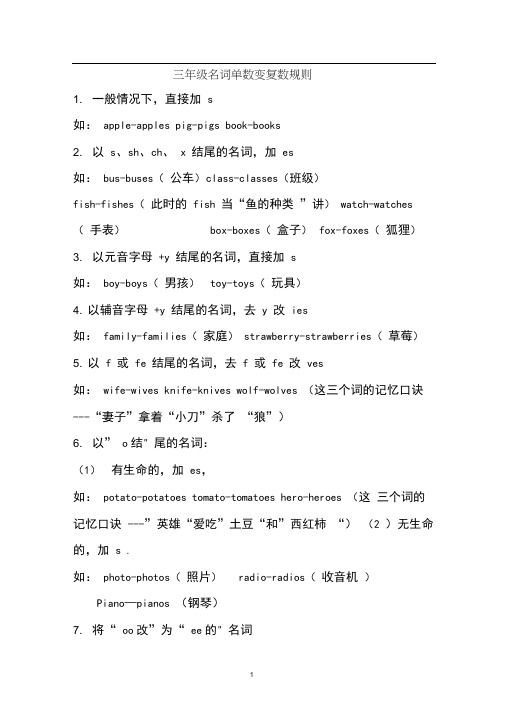
三年级名词单数变复数规则1. 一般情况下,直接加s如:apple-apples pig-pigs book-books2. 以s、sh、ch、x 结尾的名词,加es如:bus-buses(公车)c lass-classes(班级)fish-fishes(此时的fish 当“鱼的种类”讲) watch-watches (手表)box-boxes(盒子)fox-foxes(狐狸)3. 以元音字母+y 结尾的名词,直接加s如:boy-boys(男孩)toy-toys(玩具)4. 以辅音字母+y 结尾的名词,去y 改ies如:family-families(家庭) strawberry-strawberries(草莓)5. 以 f 或fe 结尾的名词,去 f 或fe 改ves如:wife-wives knife-knives wolf-wolves (这三个词的记忆口诀---“妻子”拿着“小刀”杀了“狼”)6. 以” o结" 尾的名词:(1)有生命的,加es,如:potato-potatoes tomato-tomatoes hero-heroes (这三个词的记忆口诀---”英雄“爱吃”土豆“和”西红柿“)(2 )无生命的,加s .如:photo-photos(照片)radio-radios(收音机)Piano—pianos (钢琴)7. 将“ oo改”为“ ee的" 名词如:tooth-teeth(牙) foot-feet(脚)goose-geese(鹅)8. 单复同形的名词:(1)fish-fish(此时fish 当“同类鱼的很多条”讲) sheep-sheep(绵羊)paper-paper(纸)people-people(peoples 表示“民族”)Chinese-Chinese(中国人) Japanese-Japanese(日本人)(2)不可数名词,如:water(水),rice(米饭),milk(牛奶),juice(果汁),bread(面包),tea(茶),orange(橙汁)9. 不规则变化的名词:(1)man-men,woman-women (记忆方法,“男人”变“女人”,“a” 变“ e”.延伸policeman-policemen policewoman-policem(2)child-children (孩子)(3)mouse-mice(老鼠)(4)根据中文意思变化的名词,如:I-we (我-我们) you-you (你-你们) he/she/it-they (他/ 她/ 它-他们) this-these(这个-这些)that-those(那个-那些)am/is –are (是)has-have(有)注:apple tree-apple trees man teacher-men teachers以此类推课堂练习一.出下列各词的复数。
- 1、下载文档前请自行甄别文档内容的完整性,平台不提供额外的编辑、内容补充、找答案等附加服务。
- 2、"仅部分预览"的文档,不可在线预览部分如存在完整性等问题,可反馈申请退款(可完整预览的文档不适用该条件!)。
- 3、如文档侵犯您的权益,请联系客服反馈,我们会尽快为您处理(人工客服工作时间:9:00-18:30)。
三年级英语名词单数变复数规则和练习及答案1.一般情况下,直接加s如:apple-apples pig-pigs book-books2.以s、sh、ch、x结尾的名词,加es如:bus-buses(公车) class-classes(班级)fish-fishes(此时的fish当“鱼的种类”讲)watch-watches(手表) box-boxes(盒子) fox-foxes(狐狸) 3.以元音字母+y结尾的名词,直接加s如:boy-boys(男孩) toy-toys(玩具)4.以辅音字母+y结尾的名词,去y改ies如:family-families(家庭) strawberry-strawberries(草莓)5.以f或fe结尾的名词,去f或fe改ves如:wife-wives knife-knives wolf-wolves(这三个词的记忆口诀---“妻子”拿着“小刀”杀了“狼”)6.以甥?搱屯结尾的名词:(1)有生命的,加es,如:potato-potatoes tomato-tomatoes hero-heroes(这三个词的记忆口诀---”英雄“爱吃”土豆“和”西红柿“) (2)无生命的,加s .如:photo-photos(照片) radio-radios(收音机)Piano—pianos(钢琴)7.将“oo”改为甥?挱敥的名词如:tooth-teeth(牙) foot-feet(脚) goose-geese(鹅)8.单复同形的名词:(1)fish-fish(此时fish当“同类鱼的很多条”讲)sheep-sheep(绵羊) paper-paper(纸)people-people(peoples表示“民族”)Chinese-Chinese(中国人) Japanese-Japanese(日本人)(2)不可数名词,如:water(水),rice(米饭),milk(牛奶),juice(果汁),bread(面包),tea(茶),orange(橙汁)9.不规则变化的名词:(1)man-men,woman-women (记忆方法,“男人”变“女人”,“a”变“e”.延伸policeman-policemen policewoman-policem(2)child-children(孩子)(3)mouse-mice(老鼠)(4)根据中文意思变化的名词,如:I-we (我-我们) you-you (你-你们)1 / 5he/she/it-they (他/她/它-他们)this-these(这个-这些) that-those(那个-那些)am/is –are (是) has-have(有)注:apple tree-apple trees man teacher-men teachers以此类推课堂练习一.出下列各词的复数。
1.mouse______2.this_______3.watch_______4.child_______5.photo______6.diary_______7.boy________ 8.foot________ 9.fish_______ 10.thief_______ 11.man________ 12.firman___ 13.Chinese_____ 14.deer______ 15.I ____16.tomato______ 17.brush_____ 18.glass____二、选择题。
()1.This _____a car .A . is B. are C. has( ) 2. I have two _____friend and a _____friend .A .Japanese , Chinese B.Japanese , Chinese C.Japanese , Chinese( ) 3.I want some_____.A.a fishB. fishC.fishes( ) 4.The two _____are in the room.A.man B men C.a man( ) 5.I clean _____in the morning.A.my toothB. my toothC.my teeth三、仿照例子,把下列句子中的名词改为复数形式。
例子:I am a tall boy. We are tall boys.1.She is a beautiful girl. _______________________2.He is a strong man . ______________________3.This is a big mouse. _______________________4.That is a small fish. ______________________5.It has a long tooth . ______________________英语专项测试名词复数(总分 100 分)姓名:________________ 分数: _____________一、请写出下列词的复数形式。
(1'*50=50')city______mouse________ tree______ branch_______radio_______ leaf______woman_______zoo______country_______tooth_______ boy_______broom ______car ______ bus_______fox _____2 / 5family _____ piano _____ thief_____ foot _____ dish _____ knife _____ man _______ this ______horse _____ baby _____ photo_____life_____child_______watch_______diary__________ day_________book________dress______sheep________tea________ box_______strawberry_________peach_____sandwich__________ paper_________juice__________water______milk___________rice__________people_________CD________ox___deer______ fish___________二、单项选择 (1'*10=10')( )1. The __ in our yard are very beautiful.A. clothB. waterC. flowers( )2. Tom is one of the Chinese _____ in our school.A.boyB. boysC. boies( )3. A cat has four ____ , doesn't it?A. footsB. feetC. feets( )4. There are three ____ and five _____ in the room.A. American, Japanese B Americans, JapaneseC. American, Japanese( )5. Can you see nine ____ in the picture?A. fishB. bookC. horse( )6. The _____ has two______.A. boy; watchB. boy; watchesC. boys; watch( )7. The _____ are flying back to their country.A. GermanyB. GermanysC. Germans( )8. The girl brushes her _____ every day before she goes to bed.A. toothsB. teethC. teeths( )9.I saw many _____ in the street.A. peoplesB.people(_)10.The green sweater is his _________.A.brotherB.brothersC.people'sD.brother's三、选择填空 (1'*10=10')A.countryB. countriesC. a countryD. countrys ( )2. How many ______ do you see in the picture?A.tomatosB. tomatoesC. tomatoD. the tomato ( )3. They are______.A . woman teachers B. women teachers C. women teacherD. woman teacher3 / 5( )4. Would you like _______ ,please?A. two glass of waterB. two glasses of waterC. two glass of watersD. two glasses of waters ( )5. Most of ______ live in _______.A. Germans, GermanB. German, GermenC. Germen, GermanyD. Germans, Germany( )6. There are some ______ in these _______.A. knifes pencilboxesB. knives pencilsboxC. knives pencilboxD. knives pencilsboxes( )7. ______ like ______ by air.A. Greens, travellingB. The Green, travelingC. The Greens, travelD. The Greens, traveling( )8. I wonder why ______ are interested in action films(武打片).A.the peopleB. peopleC. peoplesD. the peoples ( )9. There is no ______ in the plate.A.applesB. orangesC. riceD. eggs( )10.My uncle has three _______.A.childB.childsC.childrenD.childrens四.填入所给名词的正确形式(2'*10=20')1. I have two____________ (knife).2.There are many ___________(box) here.3.There are many ___________(bus) on the road.4.A few ___________ (boy)are drawing on the wall.5.The ______________ (child) are playing football now.6.Please take two _______________(photo) for me.7.I like the red ________________(tomato).8.Would you please clean your ____?(tooth).9.Do you want some _______?(milk)10.There are ten _______ ___________.(woman teacher)4 / 5课堂练习答案一. 1. mice 2.these 3.watches 4.children 5. photos 6.diaries7.boys 8.feet 9.fish 10.thieves 11.men 12.firmen13.Chinese 14.deer 15.we 16.tomatoes 17.brushes18.glasses二.1-5AABBC三.1.They are beautiful gils.2.They are strong men .3.These are big mice.4.Those are small fish.5.They have long teeth.三年级名词复数课后小测练习一、cites mice trees branches radios leaves women zoos coutriesteeth boys broomscars buses foxes families pianos thieves feet dishes knivesmen these horses babies photos lives children watches diariesdays books dresses sheep tea boxes strawberries peachessandwiches paper juice water milk rice people CDs oxen deerfish二、1—5CBBBA 6—10BCBBC三、1—5BBBBD 6—10DDBCC5 / 5。
